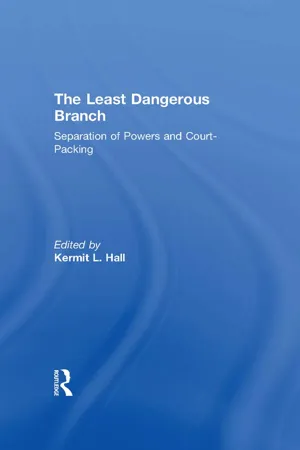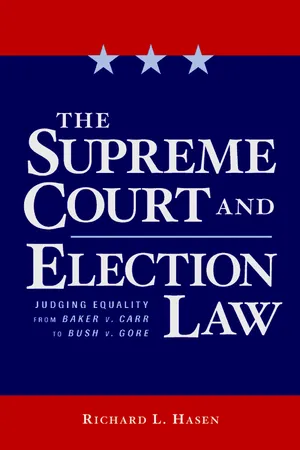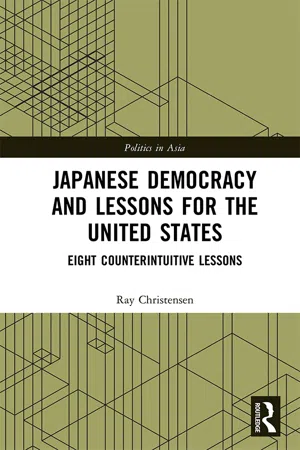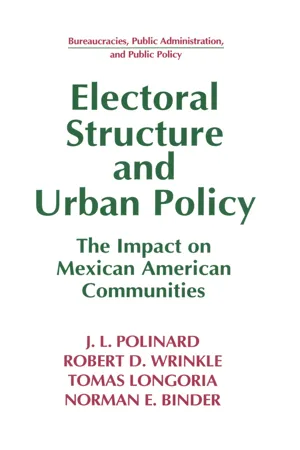Politics & International Relations
Baker v. Carr
"Baker v. Carr" was a landmark U.S. Supreme Court case in 1962 that established the principle of "one person, one vote." The ruling held that federal courts had the authority to intervene in and decide redistricting issues, ensuring that legislative districts were apportioned based on population. This decision significantly impacted the political landscape by promoting fair representation and equal voting rights.
Written by Perlego with AI-assistance
Related key terms
1 of 5
4 Key excerpts on "Baker v. Carr"
- eBook - ePub
The Least Dangerous Branch: Separation of Powers and Court-Packing
The Supreme Court in American Society
- Kermit L. Hall(Author)
- 2014(Publication Date)
- Routledge(Publisher)
Carr : Politics in Search of Law, 1962 S UP. C T. R EV. 252. 76 After Baker, the Court, in a series of decisions, overturned the line of cases dating from Smiley v. Holm and Wood v. Broom in 1932. Thus, in Gray v. Sanders, 372 U.S. 368 (1963), the Court struck down use of Georgia's county unit system in primary elections for state-wide officers. According to Mr. Justice Douglas, “[t]he conception of political equality from the Declaration of Independence, to Lincoln's Gettysburg Address, to the Fifteenth, Seventeenth, and Nineteenth Amendments can mean only one thing—one person, one vote.” Id. at 381. In like manner the Court invalidated a Georgia statute creating congressional districts because the statute abridged the guarantee of article I, section 2 of the federal constitution, providing that congressmen shall be chosen “by the People of the several States.” By 1964 the Court had come full circle, Reynolds v. Sims, 377 U.S. 533 (1964) held the existing and two proposed apportionment plans allowing substantial variances between population and representation for the Alabama Legislature unconstitutional. The dominant theme of the opinion was, of course, equal protection: “We hold, that as a basic constitutional standard, the Equal Protection Clause requires that the seats in both houses of a bicameral state legislature must be apportioned on a population basis.” Id. at 568 (emphasis supplied). As for the political question: “We are cautioned about the dangers of entering into political thickets and mathematical quagmires. Our answer is this: a denial of constitutionally protected rights demands judicial protection; our oath and our office require no less of us.” Id. at 566. On the same day Reynolds v. Sims was decided—June 15, 1964—the Court held the legislatures of five other states had been unconstitutionally apportioned. Lucas v. Forty-Fourth General Assembly, 377 U.S. 713 (Colorado); YMCA, Inc. v. Lomenzo, 377 U.S - eBook - ePub
The Supreme Court and Election Law
Judging Equality from Baker v. Carr to Bush v. Gore
- Richard Hasen(Author)
- 2003(Publication Date)
- NYU Press(Publisher)
2Judicial Unmanageability and Political Equality
A Misplaced Focus on“Judicially Manageable” Standards 1The conventional story about the Supreme Court’s decision in Baker v. Carr 2 to adjudicate disputes over legislative apportionment is that political market failure required judicial intervention. The market failed in the case of unequally populated districts because existing legislators could not be expected to vote themselves out of a job; nor would voters who benefit from the existing apportionment plan elect legislators inclined to do so.3This market failure story makes an implicit normative judgment that unequally populated districts are improper, a judgment I consider in the next chapter. The story also evinces great trust in the judiciary, a point to which I now turn. If judges are to correct political market failures, their impartiality and general wisdom must make up for a lack of particular competence—as well as lack of accountability—in dealing with political matters.Opponents of judicial intervention in politics doubted judicial competence in political cases, calling for nonjusticiability because “standards … for judicial judgment are lacking.”4 This concern over “judicial manageability” turned out to be seriously exaggerated in the legislative apportionment and districting cases, where the Court’s adoption in Reynolds v. Sims of a strict “one person, one vote” standard required little more than knowledge of “sixth grade arithmetic,”5 but it has proven more real in other cases, most recently, as I will explain, in Bush v. Gore .The Baker Court majority and dissenters apparently failed to appreciate the benefits of judicial un - eBook - ePub
Japanese Democracy and Lessons for the United States
Eight Counterintuitive Lessons
- Ray Christensen(Author)
- 2020(Publication Date)
- Routledge(Publisher)
Baker v. Carr in 1962 when the Court necessarily pared back the political question doctrine to make it possible to push into the political thicket that Justice Frankfurter had warned against. The Court limited the areas in which it would exercise restraint under the political question doctrine to only six: clear constitutional authority given to another branch of government, the lack of a clear standard by which a court could intervene, policy decisions that are clearly not appropriate for the courts, court actions that would violate respect owed to the other branches of government, unusual situations that require consistency with previous political decisions, and the potential for confusion if different parts of the same government reached different conclusions on the same issue (369 US 186, 217).On its face, Baker v. Carr ’s long list of possible uses of the political question doctrine might have seemed to be a strengthening of the doctrine. However, in the subsequent fifty years of cases, observers have concluded that the political question doctrine is largely dead (Barkow, 2002), or that it is operating in only a few limited areas (Choper, 2005). Curiously, the Court has also manifested the entire continuum of responses from restraint to intervention in its decisions in the areas of malapportionment and gerrymandering. On one extreme, the Court has intervened and regularly intervenes in redistricting to ensure the absolute equality of population of election districts within states. On these issues, the Court is standing in the middle of the political thicket, with court challenges to every redistricting plan expected, even if the legislatures and commissions have learned to anticipate and respond to many of the possible legal challenges that will inevitably be raised.On the other extreme, the Court has stayed steadfastly outside of the political thicket in the area of political gerrymandering. Though a majority of the Court has never accepted that the political question doctrine puts partisan gerrymandering questions outside of the Court’s purview, a majority has consistently failed to find any clear judicial standard that would make it possible for the Court to rule in issues of partisan gerrymandering. This lack of a clear standard in the political gerrymandering cases contrasts with the clear standard of one-person, one-vote, the basis of court interventions in redistricting for malapportionment reasons. - eBook - ePub
Electoral Structure and Urban Policy
Impact on Mexican American Communities
- J.L. Polinard, Robert D. Wrinkle, Tomas Longoria, Norman E. Binder(Authors)
- 2016(Publication Date)
- Routledge(Publisher)
In 1957 Congress passed the first civil rights bill since Reconstruction. This act represented the first modern attempt to protect the Fifteenth Amendment rights by creating a commission to investigate claims of vote denial (LeVarsky 1987, 306). The act was mostly of symbolic value, with little enforcement power, but it represented a break with the past and facilitated later action. In 1960 Congress expanded the power of the attorney general to protect black voters, and the 1964 Civil Rights Act included provisions expediting voting rights litigation. The Supreme Court also broke with the past during this period. The reapportionment decisions would establish a new view of the right to vote, one that would anticipate the dramatic shift from a jurisprudence focusing on vote denial to one focusing on vote dilution.In 1962 the Court established fairness of representation as a justiciable issue with the landmark decision of Baker v. Carr. Although Baker was a procedural decision and did not speak to an explicit constitutional remedy for unfair representation, it established that, contrary to previous jurisprudence established by the Court, the right to vote in a context other than vote denial was a justiciable right. In essence, the prohibition of vote dilution is rooted in Baker v. Carr (McDonald 1989, 1258). The decision linked the Fourteenth Amendment protections to Fifteenth Amendment case law to support the discovery of "population-based voting rights" (Blacksher and Menefee 1982,6-7).Then, in 1964, the Court decided Reynolds v. Sims 5 and, in effect, and almost certainly without intent, laid the groundwork for much of the litigation that would spring from the adoption of the VRA a year later. In Reynolds, while discussing the application of the one-person, one-vote principle to state legislatures, the Court noted:There is more to the right to vote than the right to mark a piece of paper and drop it in a box or the right to pull a lever in a voting booth. The right to vote includes the right to have the ballot counted.... It also includes the right to have the vote counted at full value without dilution or discount.... [This] federally protected right suffers substantial dilution ... [when a] favored group has full voting strength [and] the group not in favor have their votes discounted. (Reynolds,
Index pages curate the most relevant extracts from our library of academic textbooks. They’ve been created using an in-house natural language model (NLM), each adding context and meaning to key research topics.



